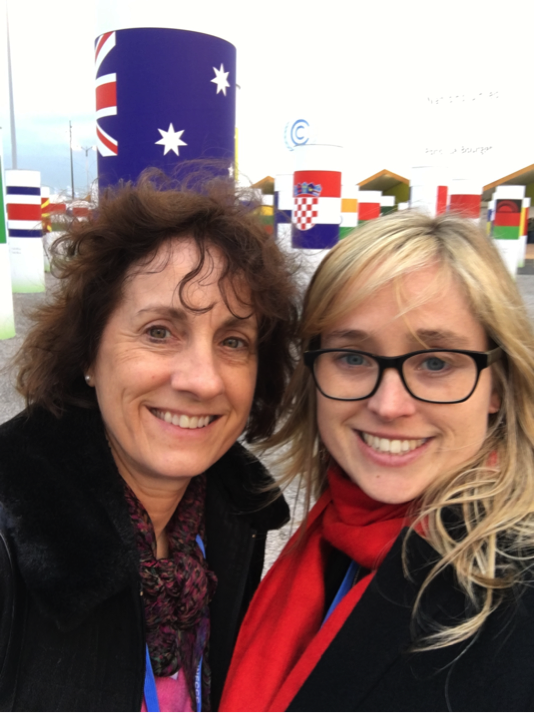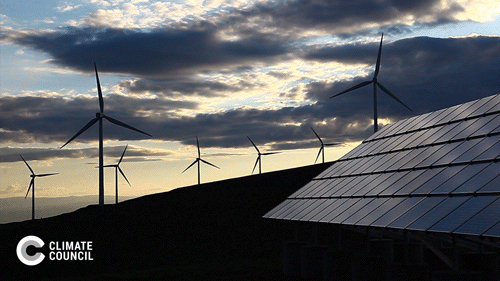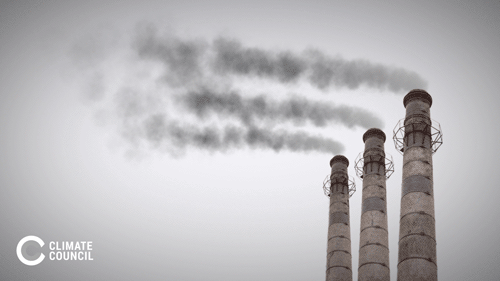Climate Council CEO Amanda McKenzie and councillors Prof Tim Flannery and Prof Lesley Hughes are at the climate talks in Paris.

They’re doing what the Climate Council does best – keeping Australians informed! You might have already seen them on Sunrise, the Today Show, ABC News 24, SBS or the Guardian. In addition to talking to journalists and finding great stories of progress from all over the world to inspire us, they’re also connecting with organisations and individuals around the world to create partnerships for the future
In the first update from the ground, Climate Council CEO Amanda McKenzie talks about why Paris is different to other climate talks and the big issues during the first two days of the conference.
Paris is different to other climate conferences – really!
The structure of the Paris climate talks is quite different to previous conferences. Countries have had to submit in advance their national pledges to reduce greenhouse gas emissions. This means they’ve done their homework. China and the US, previously laggards and the world’s largest polluters, announced their plans together a year in advance, driving significant momentum. Their commitments represent substantial departures from previous stances. For instance, China will build more zero emission energy, like solar and wind, in the next 15 years, than their entire existing coal fleet.
You probably also saw on the news that 150 heads of state were in attendance for the first day. This was the largest gathering of heads of state for any event ever! This was important in kicking off the negotiations with momentum and some greater clarity of purpose as we repeatedly heard that countries felt that tackling climate change was key to their national interest and long-term economic prosperity.
There are three reasons to be cautiously confident that this conference will have substantive and concrete outcomes.
1. The economics of climate change solutions has changed dramatically.
Since the last major climate talks in Copenhagen in 2009 investment in renewable energy has increased rapidly. The price of solar photovoltaic (PV) modules has dropped 75% while the cost of onshore wind power dropped 30%. Renewables have not only become more affordable, new wind and solar plants now compete directly with new fossil fuel plants on price in many parts of the world. This investment has been accompanied by substantial job creation. More than 7.7 million people are now employed globally in the renewable energy sector, an increase of more than 4 million since 2009. The case to scale up renewable energy investment has never been stronger.
2. Countries have moved from talk to action – really!
Since 2009, the number of countries with renewable energy targets has doubled – to over 160. This is real action, not just talk, and shows what can be achieved with policies at the national and sub-national level that promote clean energy.
3. Commitments in the lead up to Paris will further accelerate renewable energy investment.
Eight of the ten largest emitters have announced plans to scale up renewable energy in the lead up to the Paris climate conference. This represents an almost four-fold increase in generating capacity by 2030. China alone is aiming to build 800-1000 GW of low emissions capacity by 2030 – that’s more than all the coal-fired power plants that exist in China today and close to the total current electricity generation capacity of the US.
Of course, renewable energy is not the whole solution to climate change , but it’s a very important one. That’s why these three reasons give me considerable hope that we’ve moved from a phase of inaction to action. Is it sufficient? No. Countries do have to intensify their efforts even more.
Recently the Head of the UNFCCC, Christina Figueres, commented that “international negotiations don’t cause change, they mark it”. Paris already marks a significant upswing in solutions.
2 days in, what have been some of the big issues?
The issues being discussed at this meeting are complex and wide-ranging. Here are three big ones:
Renewable energy

Renewable energy was a big focus on the first and second day of the COP with three significant developments:
1. Prime Minister Modi of India and President Hollande of France together launched an international Solar Alliance between over 100 developed and developing countries, as well as industries, laboratories and institutions. India will host this initiative and contribute approximately 30 million U.S. dollars over the next 5 years to build it up. Modi also confirmed that India will add 100 GW of solar power by 2022, from a total capacity of 4 GW at present.
2. Member nations of the Climate Vulnerables Forum (including countries like Bangladesh, Philippines Sri Lanka and our neighbours, Pacific Island Countries) have shown what climate leadership looks like in launching a bold call for the world to move to 100% renewable energy by 2050. This group is calling for a complete phase out of fossil fuels by mid-century and for emissions to peak as soon as possible.
3. Bill Gates announced the biggest clean energy investment fund in history, the Breakthrough Energy Coalition. Made up of himself, and 27 other philanthropists, investment fund managers and tech CEOs, the fund is part of an initiative called Mission Innovation, that aims to reinvigorate and accelerate global clean energy innovation and make clean energy widely affordable.
Fossil fuel subsidies
New Zealand PM John Key presented a message to the forum from nearly 40 nations calling for the removal of fossil fuel subsidies. All G20 countries continue to subsidise fossil fuels (coal, oil and gas) collectively spending an estimated US$ 452 billion annually, four times the subsidies received by renewable energy.

Absurdly, many countries are currently implementing policies to tackle climate change whilst providing public subsidies for fossil fuels at the same time. Australia is included in this group – subsidising fossil fuels by $4 billion a year and paying more per head than is spent on mental health services.
Supporting poor countries to cope with climate change
Climate change is a global problem affecting all countries but some are more vulnerable than others (e.g. Australia’s Asia-Pacific neighbours), and not all nations have the capacity to deal with climate impacts. As a result, the United Nations Framework Convention on Climate Change has established a Green Climate Fund (GCF) to provide US$ 100 billion worth of resources and expertise worldwide over the next five years for poorer countries to prepare and cope with the effects of climate related disasters, as well as to reduce their emissions.
Australia announced at the climate talks here in Paris that it will contribute at least $1 billion over the next five years. However, that has been criticised by aid organisations because it involves reallocating existing money from the aid budget rather than a commitment of new money. Further, the Climate Institute and others estimate that a fair contribution from Australia’s public purse is in the order of $1.5 billion a year by 2020. More on this as the week continues.
What has Australia been doing?
Prime Minister Malcolm Turnbull arrived at the Paris talks with pollution reduction targets that are too weak to protect Australia from climate change. The targets are also considerably behind those of many of our trading partners and allies.
However, during the conference Turnbull did commit to doubling Australia’s investment in clean energy research and development as part of a global research and development fund announced by Bill Gates, in partnership with several technology innovation companies and countries. Each of the 20 participating countries (including Australia) will seek to double its state-directed clean energy research and development investment over the next five years. The details of Australia’s commitment are expected to be laid out in an innovation statement next week.
While funding for research is always welcome, we must also remember that there is no need to wait to develop solutions to tackle climate change – we have solutions already! Indeed, ClimateWorks analysis in 2014 found that Australia could achieve net zero carbon emissions by 2050 using all existing technology and maintaining economic prosperity.
Earlier this year Australia became one of the only countries to legislate to reduce its commitment to renewable energy, with the federal government slashing the renewable energy target. This will cost the country an estimated $5-6 billion in lost investment by 2020. To tackle climate change, it is critical to put in place policies that will roll out existing renewable energy technologies, as well as the next phase of R&D.
What about an agreement?
The big question on a lot of people’s’ minds is whether an agreement will be reached – although there are a number of vexed issues, we’re optimistic that there will be an agreement out of the Paris talks. The nature and the scale of the agreement is what is up for grabs this week. So watch this space!
The other question, of course, is whether that agreement will be sufficient. The short answer here, is ‘no’. Action is coming late in the game and climate change is already upon us. But, the Paris agreement will be an important milestone, marking substantive change that is happening world wide. As you know, action will have to continue to accelerate if we’re going to avoid the worst impacts of climate change.
Image credits:
- Flickr user U.S. Embassy The Hague licensed under CC BY-ND 2.0
- Photo: AP (http://www.smh.com.au/environment/un-climate)